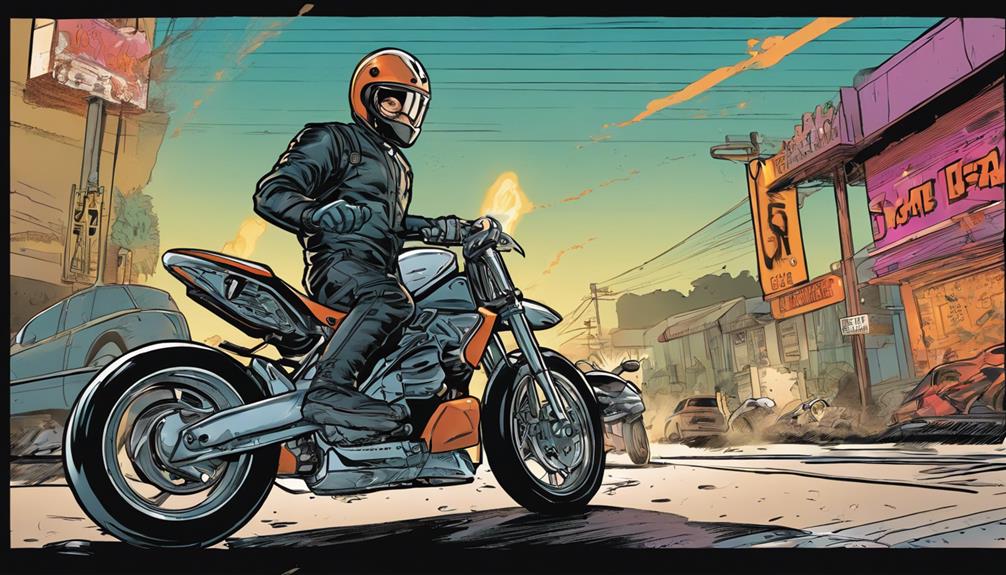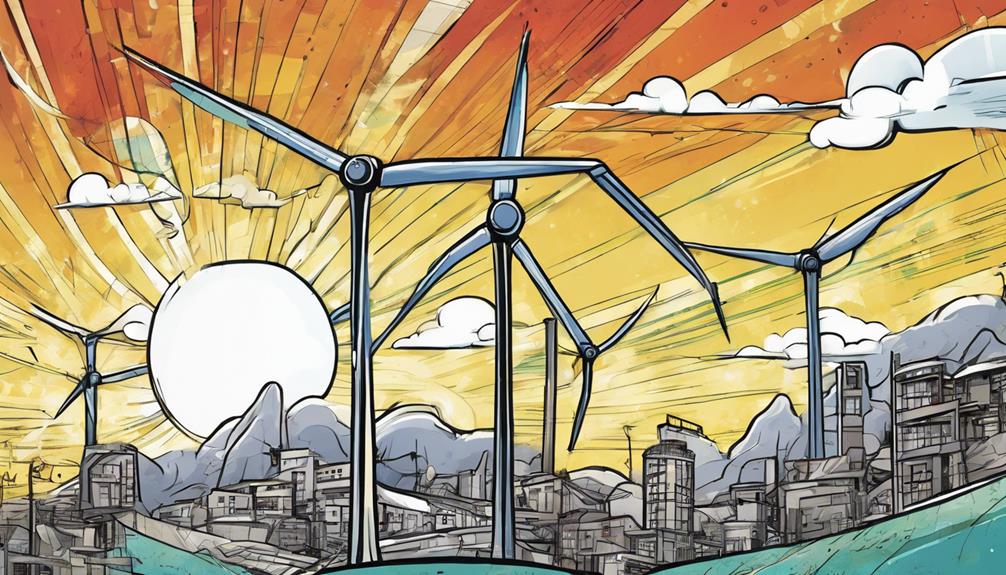When riding electric motorcycles in California, you must guarantee the motor power is under 750 watts and speeds do not surpass 28 mph to follow state laws. California categorizes electric motorcycles into three groups based on their electric assist capabilities. Riders are not needed to have a license, registration, or insurance to operate legally on public roads. Understanding these regulations is vital for your safety and adherence to the law. Familiarize yourself with the specific power limits and speed restrictions to prevent fines or penalties. Compliance is essential for a safe and enjoyable riding experience in the state.
Key Takeaways
- Electric motorcycles in California must not exceed 750 watts and 28 mph.
- Three classes based on electric assist capabilities categorize electric motorcycles.
- No license, registration, or insurance required to operate electric motorcycles.
- California law treats electric motorcycles as motorized bicycles.
- Regulations ensure safety and compliance for electric motorcycle riders in California.
Terminology and Design
When discussing terminology and design of electric motorcycles in California, it's important to understand their classification under the California Vehicle Code. Electric motorcycles in California fall under the category of motorized bicycles. According to the California Vehicle Code, these motorized bicycles must adhere to specific regulations to be considered legal. This includes having a motor power that doesn't exceed 750 watts and a speed limit of 28 mph.
One key safety feature designed into electric motorcycles is the automatic disengagement of the motor when brakes are applied. This safety mechanism guarantees a quick response in emergency situations, enhancing rider safety on the road.
Furthermore, California law divides electric motorcycles into three distinct classes based on their electric assist capabilities. These classifications help in defining where and how these vehicles can be operated within the state.
Despite being classified as motorized bicycles, riders of electric motorcycles in California aren't required to possess a license, register their vehicle, or obtain insurance to legally operate them on public roads. This exemption aims to promote the use of electric motorcycles as a sustainable and convenient mode of transportation.
Historical Development and Innovations

To understand the evolution of electric motorcycles in California, it's important to explore their historical development and the innovations that have shaped the industry over time. Here are some key points to examine:
- Motorized bicycles have a rich history dating back to the late 1800s, initially powered by steam and gasoline.
- Early producers such as Minerva, Phelon & Rayner, and California Motor Company played pivotal roles in the development of motorized bicycles.
- Innovations like the Singer Motor Wheel and Smith Motor Wheel were transformative, pushing the boundaries of motorized bicycle technology.
- Purpose-built motorized bicycles like Derny and VéloSoleX from France showcased advancements in design and functionality.
Gasoline-powered motorized bicycles, exemplified by models like the Whizzer in the 1930s, reflected the ongoing innovation in the industry. These early developments laid the foundation for the advancements and technologies we see in electric motorcycles today.
Modern Trends and Impact

Amid the shifting landscape of transportation preferences, electric motorcycles are making a substantial impact in California due to their eco-friendly characteristics and efficient performance. The adoption of electric motorcycles aligns with the state's focus on reducing emissions and promoting sustainable transportation options.
In addition to electric motorcycles, electric bicycles are also gaining popularity as convenient and environmentally friendly modes of transport in urban areas. Electric motorcycles offer a quiet and smooth ride, ideal for urban commuting and reducing noise pollution. Advancements in battery technology have made electric motorcycles more accessible, affordable, and practical for everyday use in California.
Moreover, the increasing availability of charging infrastructure supports the growth of electric motorcycles as a viable alternative to traditional gas-powered bikes. As these modern trends continue to evolve, electric motorcycles and electric bicycles are becoming integral parts of the state's transportation ecosystem, contributing to a cleaner and more sustainable future.
Global Spread and Production

Manufacturers from various countries have contributed to the global spread and production of motorized bicycles, showcasing the diverse international presence of this popular mode of transportation. Here are some key points to ponder:
- Japanese Influence: Mopeds from Japan by manufacturers like Honda and Yamaha have played a significant role in popularizing motorized bicycles worldwide.
- Iconic Brands: Production of iconic brands like VELOSOLEX continues in countries such as China and France, highlighting the international production of motorized bicycles.
- Global Popularity: Motorized bicycles remain prevalent in countries like France, Italy, Germany, and the USSR, indicating their widespread appeal and usage on a global scale.
- Diverse Market: Aftermarket conversion kits and the production of motorized bicycles cater to various markets globally, underscoring the diverse availability of motorized bicycle options worldwide.
The global spread and production of motorized bicycles reflect their versatility and utility, making them a popular choice across different cultures and regions.
Legal Status and Regulations

Understanding the legal requirements for electric motorcycles in California is essential for riders to guarantee compliance with safety regulations. In California, laws governing electric motorcycles include specific maximum power limits and speed restrictions. It's crucial that electric motorcycles in the state adhere to these regulations to ensure the safety of riders and other road users.
Failure to comply with California's electric motorcycle laws can result in fines or penalties, underscoring the importance of being informed about the legal status and regulations. By following the regulations set forth for electric motorcycles, riders can contribute to promoting responsible and safe riding practices on the roads.
It's essential to note that regulations for electric motorcycles in California may differ from those for traditional motorcycles, highlighting the need for awareness and adherence to the specific laws governing electric vehicles in the state.
Safety Regulations and Compliance

You must wear a helmet if you're under 18 when riding an electric motorcycle in California.
The speed limit for electric motorcycles is capped at 28 mph, and you're required to adhere to all traffic laws just like any other motor vehicle.
California treats electric motorcycles similarly to cars regarding DUI laws and licensing regulations.
Helmet Laws in California
When riding an electric motorcycle in California, wearing a helmet is necessary for individuals under 17 years old. Adhering to this regulation is essential for ensuring safety and avoiding legal repercussions.
Here are some key points to understand about helmet laws in California:
- Age Requirement: Individuals under 17 years old must wear a helmet while operating an electric motorcycle.
- Penalties: Failure to comply with helmet laws can lead to fines and penalties in California.
- Safety Benefits: Wearing a helmet can reduce the risk of head injuries by nearly 50% for electric motorcycle riders in California.
- Legal Comparison: California treats riders of electric motorcycles under 17 similarly to bicycle riders, making helmet use mandatory for both categories.
Speed Limits Overview
To secure compliance with safety regulations and avoid penalties in California, electric motorcycle riders must adhere to a maximum speed limit of 28 mph. Exceeding this speed limit can lead to fines and penalties, jeopardizing both your safety and legal standing.
By respecting the designated speed limits on roads and bike lanes, you not only enhance your safety but also guarantee that you're abiding by California laws governing electric motorcycles. Understanding and following these speed limits are essential for a secure and lawful riding experience.
Whether you're cruising through city streets or enjoying the scenic routes, maintaining a speed of 28 mph or below is pivotal. Stay vigilant, watch your speedometer, and prioritize safety by adhering to the prescribed speed limits.
Traffic Regulations Summary
Understanding and adhering to traffic regulations, including safety requirements and compliance standards, is crucial for electric motorcycle riders in California. To safeguard your safety and legal compliance while riding your e-motorcycle, here are some key traffic regulations to keep in mind:
- Helmet Requirement: Riders under 18 must wear helmets when operating electric motorcycles in California.
- Adherence to Traffic Laws: Electric motorcycles must obey the same traffic laws as motor vehicles in the state.
- Speed Limit Compliance: Riders are obligated to follow posted speed limits to uphold safety on the road.
- Equal Treatment: E-motorcycles are subject to the same vehicle laws as cars, highlighting the significance of understanding and following all traffic regulations.
Helmets and Safety Gear

You must always wear a helmet when riding an electric motorcycle in California, especially if you're under 18. Helmets are essential for your safety, greatly reducing the risk of head injuries in case of accidents.
Additionally, consider investing in reflective clothing and other protective gear to enhance visibility and minimize injury risks.
Helmet Safety Importance
Wearing a helmet while riding an electric motorcycle in California is essential for ensuring your safety on the road. Here's why helmet safety is of utmost importance:
- Legal Requirement: California mandates all electric motorcycle riders to wear helmets for their safety.
- Under 18 Rule: Riders under 18 must wear helmets by law when operating electric motorcycles.
- Injury Risk Reduction: Helmets decrease the risk of head injury by almost 50% during electric motorcycle accidents.
- Pre-Ride Protocol: To comply with California's laws, helmets must be worn before igniting your electric motorcycle.
Gear for Rider Safety
When riding an electric motorcycle in California, ensuring you have the right gear, including helmets and safety equipment, is essential for your protection on the road.
Helmets play a pivotal role in minimizing head injury risks and are mandatory for all riders, not just those under 17 years old.
Wearing proper safety gear, such as reflective clothing, is also crucial to enhance visibility, especially during night rides.
It's important to remember that helmets aren't only for your safety but also a legal requirement in California. By making sure you wear your helmet before starting your ride, you not only comply with the law but also promote safe riding practices.
Proper safety gear is your first line of defense against injury, particularly during high-speed turns or unexpected incidents.
Reflective Clothing Benefits
Enhancing visibility through reflective clothing is a crucial safety measure for electric motorcycle riders in California, especially during low-light conditions.
Here are four key benefits of incorporating reflective clothing into your riding gear:
- Increased Visibility: Reflective clothing helps other drivers spot you more easily, reducing the risk of accidents, particularly during night rides.
- Reduced Collision Risk: Wearing reflective gear, along with helmets, notably decreases the chances of collisions on the road.
- Enhanced Road Safety: Safety gear like reflective clothing is vital for ensuring that you're easily seen by other vehicles, promoting overall road safety.
- Conspicuity to Drivers: By integrating reflective elements into your clothing and gear, you become more conspicuous to drivers, lowering the likelihood of accidents and enhancing your safety while riding.
Riding Regulations and Practices

To ride an electric scooter in California, you must adhere to specific regulations and practices set forth by the state. E-scooter riders are required to follow traffic rules applicable to motor vehicles, ensuring safety for both riders and pedestrians. One key regulation mandates the use of bike lanes, promoting a safer environment for all road users. Riding in designated bike lanes is not only a legal requirement but also helps in preventing accidents and traffic congestion.
Here is a breakdown of some crucial regulations and practices for e-scooter riders in California:
| Riding Regulation | Description |
|---|---|
| Use of Bike Lanes | Mandatory for e-scooter riders in California. |
| One-Way Riding | Enforced in bike lanes unless otherwise indicated. |
| Traffic Law Compliance | Essential for safe and responsible riding. |
| Speed Limit Adherence | Must be followed at all times. |
| Potential Consequences | Fines or jail time for violating regulations. |
Adhering to these regulations and practices is essential for a smooth and safe e-scooter riding experience in California.
Frequently Asked Questions
Are Helmets Required for Electric Bikes in California?
Helmets are required for electric bikes in California, especially for riders under 18 and on Class 3 e-bikes exceeding 28 mph. Emphasizing safety, the state mandates helmet use for minors to reduce head injury risks and promote safe riding practices.
Do Electric Bikes Need a License Plate in California?
You don't need a license plate for electric bikes in California. They are treated like conventional bicycles, so no plate is required. Just make sure you follow the specific power and speed limits set for electric bikes.
What Is the Vehicle Code for Electric Bike in California?
Just like a well-oiled machine, you operate your electric bike in California under the Vehicle Code Section 312.5. Remember, it's all about staying safe and following the rules of the road.
Are 1000 Watt Ebikes Legal in California?
Yes, 1000 watt ebikes are legal in California as long as they meet the state's requirements for pedal-assist electric bicycles. Remember, riders must be at least 16 years old to operate these bikes on public roads in California.
How Do Electric Motorcycle Laws in California Compare to E-Bike Regulations?
In California, the rise of EBikes urban mobility has led to updated regulations on electric motorcycles and e-bikes. While electric motorcycles are subject to traditional motorcycle laws, e-bikes have separate rules based on their speed and power capabilities. Understanding the distinctions is crucial for riders to ensure compliance with state laws.
Conclusion
Now that you know the ins and outs of electric motorcycle laws in California, you're ready to hit the road with confidence. Remember, safety always comes first, so make sure to gear up properly and follow all regulations while enjoying the ride.
With the advancements in technology and the growing popularity of electric motorcycles, it's an exciting time to be a rider in the Golden State. So, get out there and experience the thrill of the open road on your electric bike!










